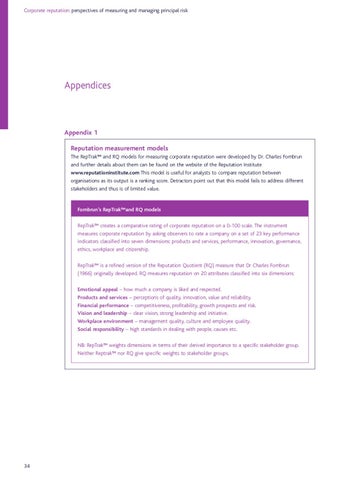Corporate reputation: perspectives of measuring and managing principal risk
Appendices
Appendix 1 Reputation measurement models The RepTrak™ and RQ models for measuring corporate reputation were developed by Dr. Charles Fombrun and further details about them can be found on the website of the Reputation Institute www.reputationinstitute.com This model is useful for analysts to compare reputation between organisations as its output is a ranking score. Detractors point out that this model fails to address different stakeholders and thus is of limited value.
Fombrun’s RepTrak™and RQ models RepTrak™ creates a comparative rating of corporate reputation on a 0-100 scale. The instrument measures corporate reputation by asking observers to rate a company on a set of 23 key performance indicators classified into seven dimensions: products and services, performance, innovation, governance, ethics, workplace and citizenship. RepTrak™ is a refined version of the Reputation Quotient (RQ) measure that Dr Charles Fombrun (1966) originally developed. RQ measures reputation on 20 attributes classified into six dimensions: Emotional appeal – how much a company is liked and respected. Products and services – perceptions of quality, innovation, value and reliability. Financial performance – competitiveness, profitability, growth prospects and risk. Vision and leadership – clear vision, strong leadership and initiative. Workplace environment – management quality, culture and employee quality. Social responsibility – high standards in dealing with people, causes etc. NB: RepTrak™ weights dimensions in terms of their derived importance to a specific stakeholder group. Neither Reptrak™ nor RQ give specific weights to stakeholder groups.
34
